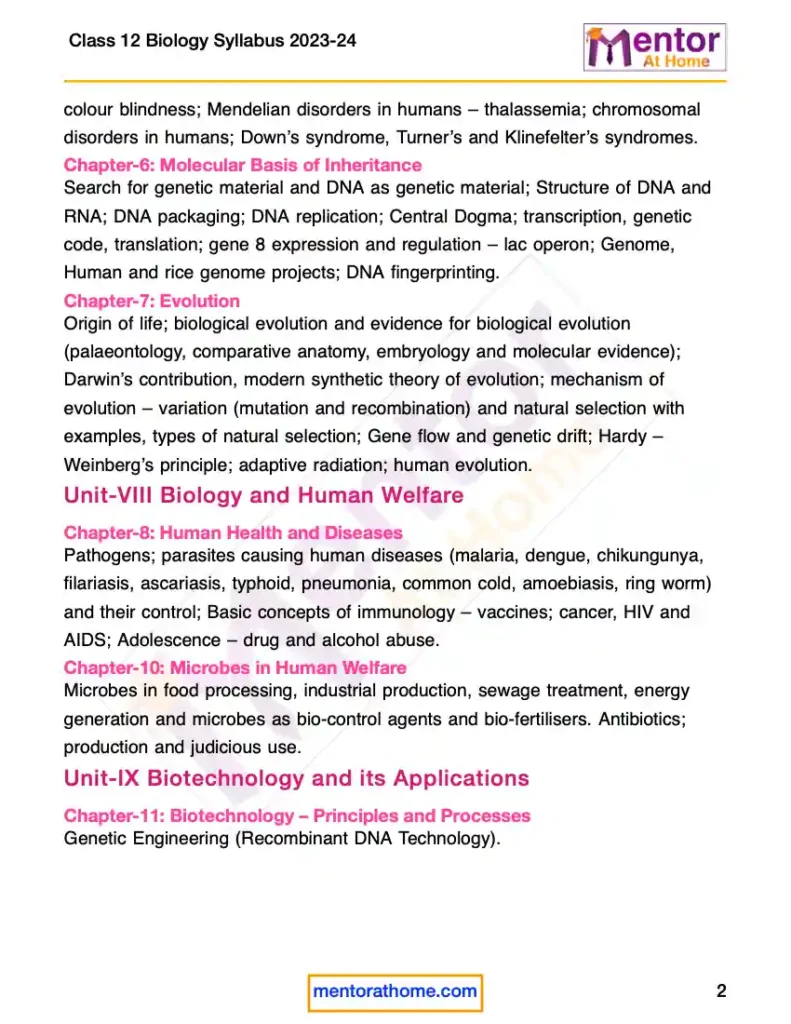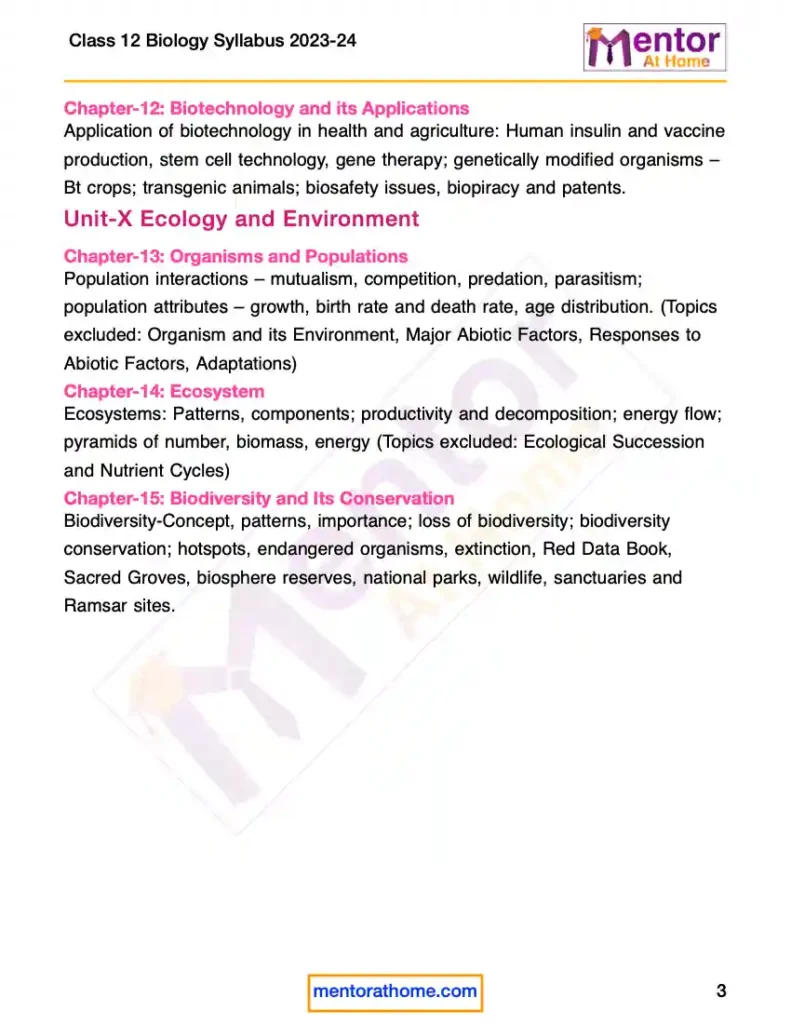Class 12th Biology Syllabus 2023-24
Here we provide the latest CBSE Class 12 Biology Syllabus 2023 24. You can also Download the new and revised CBSE Class 12 Bio syllabus PDF. The present revised syllabus of class 12 Biology has been designed in accordance with National Curriculum Framework 2005.
Biology is a scoring subject but needs a lot of practice and conceptual understanding of the topics. CBSE Biology syllabus class 12 helps you understand the important topics. We advise you to read the CBSE class 12 Biology syllabus 2023 24 carefully. Class 12th Biology syllabus also helps you in preparation for competitive exams like IIT, AIEEE etc.
You may also like
- Class 12 NCERT Solution
- Class 12 NCERT Books
- Class 12 NCERT Notes
- Class 12 Syllabus for all Subjects
CBSE Class 12 Biology Syllabus 2023-24 Pdf
Click here to download Class 12th Biology Syllabus Pdf
CBSE Syllabus of Class 12 Biology 2023 24
The detailed and chapter-wise Biology Class 12 Syllabus 2023 24 is given below:
Unit-VI Reproduction
Chapter-2: Sexual Reproduction in Flowering Plants
Flower structure; development of male and female gametophytes; pollination – types, agencies and examples; out breeding devices; pollen-pistil interaction; double fertilization; post-fertilization events – development of endosperm and embryo, development of seed and formation of fruit; special modes- apomixis, parthenocarpy, polyembryony; Significance of seed dispersal and fruit formation.
Chapter-3: Human Reproduction
Male and female reproductive systems; microscopic anatomy of testis and ovary; gametogenesis -spermatogenesis and oogenesis; menstrual cycle; fertilisation, embryo development upto blastocyst formation, implantation; pregnancy and placenta formation (elementary idea); parturition (elementary idea); lactation (elementary idea).
Chapter-4: Reproductive Health
Need for reproductive health and prevention of Sexually Transmitted Diseases (STDs); birth control – need and methods, contraception and medical termination of pregnancy (MTP); amniocentesis; infertility and assisted reproductive technologies – IVF, ZIFT, GIFT (Elementary idea for general awareness).
Unit-VII Genetics and Evolution
Chapter-5: Principles of Inheritance and Variation
Heredity and variation: Mendelian inheritance; deviations from Mendelism – incomplete dominance, co-dominance, multiple alleles and inheritance of blood groups, pleiotropy; elementary idea of polygenic inheritance; chromosome theory of inheritance; chromosomes and genes; Sex determination – in humans, birds and honey bee; linkage and crossing over; sex-linked inheritance – haemophilia, colour blindness; Mendelian disorders in humans – thalassemia; chromosomal disorders in humans; Down’s syndrome, Turner’s and Klinefelter’s syndromes.
Chapter-6: Molecular Basis of Inheritance
Search for genetic material and DNA as genetic material; Structure of DNA and RNA; DNA packaging; DNA replication; Central Dogma; transcription, genetic code, translation; gene 8 expression and regulation – lac operon; Genome, Human and rice genome projects; DNA fingerprinting.
Chapter-7: Evolution
Origin of life; biological evolution and evidence for biological evolution (palaeontology, comparative anatomy, embryology and molecular evidence); Darwin’s contribution, modern synthetic theory of evolution; mechanism of evolution – variation (mutation and recombination) and natural selection with examples, types of natural selection; Gene flow and genetic drift; Hardy – Weinberg’s principle; adaptive radiation; human evolution.
Unit-VIII Biology and Human Welfare
Chapter-8: Human Health and Diseases
Pathogens; parasites causing human diseases (malaria, dengue, chikungunya, filariasis, ascariasis, typhoid, pneumonia, common cold, amoebiasis, ring worm) and their control; Basic concepts of immunology – vaccines; cancer, HIV and AIDS; Adolescence – drug and alcohol abuse.
Chapter-10: Microbes in Human Welfare
Microbes in food processing, industrial production, sewage treatment, energy generation and microbes as bio-control agents and bio-fertilizers. Antibiotics; production and judicious use.
Unit-IX Biotechnology and its Applications
Chapter-11: Biotechnology – Principles and Processes
Genetic Engineering (Recombinant DNA Technology).
Chapter-12: Biotechnology and its Applications
Application of biotechnology in health and agriculture: Human insulin and vaccine production, stem cell technology, gene therapy; genetically modified organisms – Bt crops; transgenic animals; biosafety issues, biopiracy and patents.
Unit-X Ecology and Environment
Chapter-13: Organisms and Populations
Population interactions – mutualism, competition, predation, parasitism; population attributes – growth, birth rate and death rate, age distribution. (Topics excluded: Organism and its Environment, Major Abiotic Factors, Responses to Abiotic Factors, Adaptations)
Chapter-14: Ecosystem
Ecosystems: Patterns, components; productivity and decomposition; energy flow; pyramids of number, biomass, energy (Topics excluded: Ecological Succession and Nutrient Cycles)
Chapter-15: Biodiversity and Its Conservation
Biodiversity-Concept, patterns, importance; loss of biodiversity; biodiversity conservation; hotspots, endangered organisms, extinction, Red Data Book, Sacred Groves, biosphere reserves, national parks, wildlife, sanctuaries and Ramsar sites.
CBSE Class 12 Biology Syllabus 2023- 24 – Course Structure
Before you read the Class 12 Biology syllabus you have to understand the course structure to complete the CBSE Syllabus for Class 12 Biology 2023-24.
| Unit | Title | Marks |
| VI | Reproduction | 16 |
| VII | Genetics and Evolution | 20 |
| VIII | Biology and Human Welfare | 12 |
| IX | Biotechnology and its Applications | 12 |
| X | Ecology and Environment | 10 |
| Total | 70 | |


